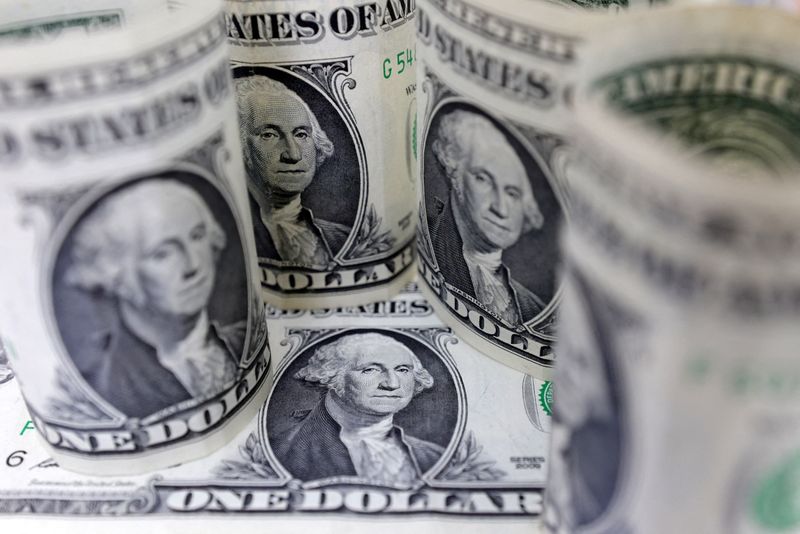By Tom Westbrook
SINGAPORE (Reuters) - The dollar was headed for its best week in a month on Friday, as hawkish remarks from Federal Reserve officials and stronger-than-expected retail sales data put the brakes on a pullback that was triggered by signs of softening inflation.
It was helped overnight, too, by a 0.4% fall in sterling after Britain's budget for tax rises and spending cuts disappointed investors.
St Louis Fed President James Bullard was the latest Fed official to push back on market hopes for a pause in interest rate hikes, saying that even on dovish assumptions, the funds rate needs to rise to at least 5-5.25% to curb inflation, from 3.75-4% currently.
More pessimistic assumptions would recommend it climb above 7%, he said.
The dollar rose modestly on the yen following Bullard's comments and is up about 1% for the week, but was straddling40 per dollar as the day wore on, off highs of 140.495 yen.
It also rose 0.9% on the Australian dollar overnight to $0.6690 per Aussie, and is on course for its first weekly gain on the Aussie since mid-October.
Another reason for the dollar bid seemed to be news that North Korea had fired a suspected intercontinental ballistic missile, just as leaders of South Korea, Japan, the United States and other nations meet at the Asia-Pacific Economic Cooperation (APEC) summit.
The U.S. dollar index is up about 0.16% so far this week to 106.59, stabilising after a small miss on U.S. inflation last week triggered one of the dollar's sharpest weekly drops in the free-floating exchange rate era on excitement about an end to rate hikes.
Treasury yields too rose after Bullard, but not enough to scale the week's peaks, with 10-year yields trading narrowly around 3.76%.
"The Fed obviously doesn't want to acknowledge (that possibility) and has been saying there's a lot more work to be done," said Jason Wong, senior strategist at BNZ in Wellington.
"Markets are looking for further confirmation from the data," he said, with U.S. inflation readings for November and December crucial for discerning a trend.
Fed funds futures pricing currently implies a peak rate just below 5% and for rates to start falling by late 2023. The Fed next meets Dec. 13-14.
Earlier this week, stronger-than-expected retail sales data had also shaken hopes for a pause in hikes, since it seemed to suggest consumers remained in spending mode.
In Japan, data showed consumer prices are surging at their fastest pace in 40 years, potentially putting pressure on authorities to step back from super-easy monetary policies, but the yen showed little immediate reaction.
Later on Friday, British retail sales data is due, and European Central Bank President Christine Lagarde is among a smattering of policymakers due to speak.
The New Zealand dollar was firm at $0.6153 as traders turn their attention to next week's central bank meeting in Wellington, with markets divided over whether a 50 basis point or 75 bp hike is in the offing.
========================================================
Currency bid prices at 0542 GMT
Description RIC Last U.S. Close Pct Change YTD Pct High Bid Low Bid
Previous Change
Session
Euro/Dollar
$1.0364 $1.0365 -0.01% -8.84% +1.0391 +1.0358
Dollar/Yen
140.0500 140.1800 -0.33% +21.48% +140.4900 +139.7200
Euro/Yen
145.16 145.29 -0.09% +11.39% +145.5500 +144.9600
Dollar/Swiss
0.9522 0.9523 -0.01% +4.39% +0.9530 +0.9514
Sterling/Dollar
1.1893 1.1868 +0.23% -12.05% +1.1930 +1.1859
Dollar/Canadian
1.3321 1.3328 -0.05% +5.36% +1.3329 +1.3300
Aussie/Dollar
0.6705 0.6690 +0.24% -7.75% +0.6725 +0.6682
NZ
Dollar/Dollar 0.6157 0.6131 +0.51% -9.96% +0.6173 +0.6120
All spots
Tokyo spots
Europe spots

Volatilities
Tokyo Forex market info from BOJ